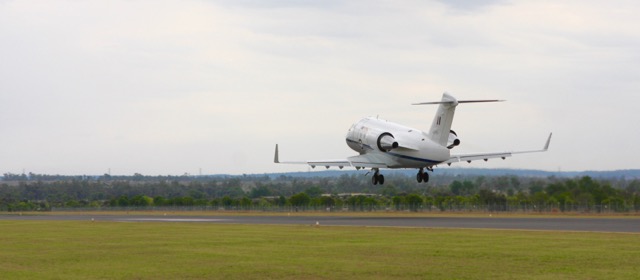
Posts about stuff relating to airports

One Step Back...
In continuing this little series I've got going here, I'd like to just quickly go back over a couple of points from last time. I'm trying to keep these posts relatively short. So that means I may have moved on to my next point a little too quickly. I guess the crux of the last post was that a graduated consequence scale is inappropriate in an aviation safety context. My two main points to back up that statement were:
the potential for a catastrophic event is persistent to the primary aviation activity of flying from A to B; and
that given aviation is a complex socio-technical system, risk conditions (call them hazards, events, or even just risks) upstream of the ultimate condition (death by aviation) cannot be categorised effectively.
I tried a few of these arguments out on some colleagues and they seemed unconvinced. So, I'm going to work on them a bit more here - this blogging thing is much more for my benefit than yours but thanks for stopping by anyway ;).
One step back...

Vulnerability & Proximity
In my last post, I commenced a whinge about the PIG or as it is more commonly known, the likelihood-consequence matrix. I signed off that post with a promise to further the discussion on the risk matrix within an aviation safety context. Here goes...
Consequence is an inappropriate dimension to consider in aviation safety. For two reasons which I call vulnerability and proximity. Let's take them in turn.

My Problem with PIGs
You can't swing a euphemism without hitting one when you're playing in the risk management metaphor. They're everywhere. Whenever you start looking at anything risk management related, you are sure to find a PIG. PIG stands for Probability-Impact Graph - otherwise known as likelihood-consequence matrix or frequency-severity chart or some combination of these words. I'm most familiar with the LxC matrix label, so I'll use it from here on in.
Over the past year or so, I've being growing more and more uneasy with the application of this tool within the aviation safety environment. I wasn't seeing, however, the same discontent in others and therefore, started to doubt my own reservations. Luckily, I found some like-minded people over at LinkedIn (membership to both LinkedIn and the group are required to view the actual discussion) with a Mr Stephen Cresswell putting his thoughts on paper here.

Safety Hero: Roger Boisjoly
It's a slice of history every safety professional should know - the night before the Challenger disaster, engineers at NASA-contractor Morton Thiokol made a recommendation that the launch not proceed. One of the engineers that really tried to stop it died today.

"Compliance Doesn't Equal Safety"
I've heard this saying quite a bit over the last few months and in at least one aspect, I agree with the statement. It tends to be true that regulations have failed to keep pace with industry. As such, blind compliance with the regulation no longer ensures an accident-free existence. So what is the solution?
Image: Tanathip Rattanatum

Unhappy? No, but...
After a short hiatus and a new job, I've decided to start blogging again. This time on topics related to my new job. My old blog was slanted towards airport safety but with my shift into a more general and strategic role, I thought I'd shift the blogging to a new home and recommence putting my thoughts out there. The name of this blog comes from a chapter in James Reason's 1997 book, managing the risks of organisational accidents. In it, Professor Reason provided a number of reasons why the regulator's lot is an unhappy one.
Image credit: Andrea Piacquadio (via Pexels)

A Change of Scene
As you can no doubt tell, I haven't been blogging much over the last couple of months. The reason behind this is that I went and got myself a new job. Same place but a new role. I'm no longer an aerodrome inspector. Instead, I've moved into a much more strategic role in the Safety Systems Office at the Civil Aviation Safety Authority.
Header image: Alexas Fotos (via Pexels)

Doing the Right Thing for the Right Reasons
A couple of weeks ago a question came into the Aerodromes Inspectorate at work regarding the accuracy of airline scales at airports. In Australia, that's not necessarily an airport operator's responsibility and is not covered by our aerodrome regulations. Anyway, that's not the point of this post. This earlier event made me notice this story from the LA Times on the same topic, so I read with interest to see what other countries do. I couldn't exactly work out whether it was the airport or airlines responsibility but in Los Angeles at least, a government department comes in to give the scales the big tick of approval. But the angle of the story was what really stood out.
Image credit: Jens Johnsson (via Pexels)

Bird Control Dessert: Fungrass*
Last week I blogged about the ACRP's new synthesis report on bird control techniques and on that very day, Airport International News reported on deterrent grass developed in New Zealand. This new grass is still being tested in NZ so its no wonder it didn't make it into the ACRP's report…
Header image: abdul7amid alfadhly (via Pexels)

Wrong Runway, Go'Round
If you're not into aviation, like most Australian airport operators, you might think that some of those stories you hear from fanatics like me are a bit far-fetched. In my early days in aviation, I thought the same about the stories involving pilots putting their aircraft down on the wrong runway. Surely not...
Unfortunately, it has happened with the latest incident occurring less than two months ago. This time it involved a CRJ-200 and a new but not yet operational parallel runway. Luckily, according to this site, no one was injured.
Header image: William Mattey (via Pexels)

Airport Heavy Metal
For those engineers, works supervisors and general road-works warriors out there, here is a cool new video of trucks, asphalt, men and some more trucks as they overlay one of Melbourne Airport's runways. Enjoy :).

5 Ways to Improve Your Aerodrome Manual
I've seen my fair share of aerodrome manuals. Every audit begins with a review of an aerodrome manual and in my past life as a consultant, I wrote a few as well. Unfortunately, the state of the vast majority of aerodrome manuals I've encountered, including my own, could best be described as "needs improvement". But before we get to the tips, let’s just rehash the aerodrome manual rationale. Why do we have this document?

ATI Inspector Form
Very few aerodromes I visit take the time to make sure the person or persons who carry out their aerodrome technical inspections meet the qualification and experience requirements laid out in CASR 139.240. So, to help you out, I developed an easy to use form that helps guide you through the process and satisfy the record keeping expectations of regulators.
Image credit: Andrea Piacquadio (via Pexels)

The Bird Control Smörgåsbord
The Airport Cooperative Research Program has just released a synthesis of the many and varied bird control techniques in use at airports today. Its official title is ACRP Synthesis 23: Bird Harassment, Repellent, and Deterrent Techniques for Use on and Near Airports and its appears to have been no small undertaking.

FODtube.com*
Last week's post on Foreign Object Debris got me surfing youtube.com for some videos: First up is a short video on some of Denver Airport's FOD control activities - pretty low tech stuff but they appear happy with it.


Runways Made Safer? Yeah but…
I caught this story on the web last week. According to the press release (eh, I mean) article, aircraft are falling apart during take-off and landing and the frontline of defence, airport safety officers, are prone to error. Enter the saviour – FOD radar. Okay, that's a cruel, exaggerated (mis)representation.
I will admit that Foreign Object Debris (FOD) is a very real problem for aviation and airports, in particular. Skybrary puts the yearly cost at $4 billion per year (including wildlife) and the list of FOD-induced crashes is often headlined by the 2000 Concorde disaster.
It's the mis-characterisation of runway inspections that gets to me as it seems that the article is trying to paint the following picture:
Image credit: Darli Donizete (via Pexels)

Obstacle Limitation Surface 3D Visualisation
Here is the product of a couple more nights drawing on my mac. They are the MOS 139 compliant (or there abouts) obstacle limitation surfaces for the main runway at Brisbane Airport.
Header image: Aleksandar Pasaric (via Pexels)

Wildlife Management & SMS Integration
I may have suggested a couple of weeks ago that I was not going to carry on with material from my Indonesia trip in June but I really wanted to share this fictional case study with you. In order to highlight the interaction between strategic level SMS risk management and the more operational level risk management found in wildlife management plans, I developed the case study below. Its not really based on anything I've seen in action but more based on how I would approach the problem if anyone put me in charge.
Image credit: Adrianna Calvo (via Pexels)

Good Management Practice
I was skulking around on the web the other day and I came across this blog post* featuring a Q&A with Rehbein AOS's Ben Hargreaves. While the post isn't talking airport safety, it does go into the role of airports in the regional/remote environment and it does mention a couple of good management practices. I like the discussion on the role of the airport in a regional community.
